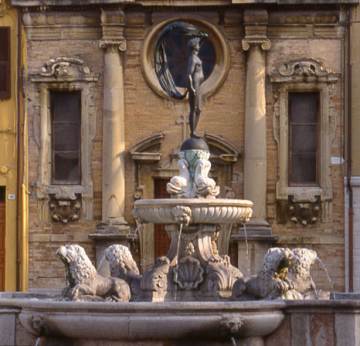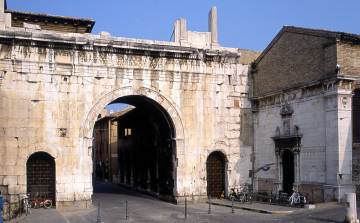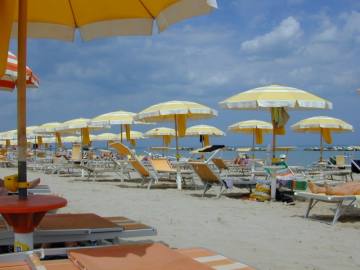|
The Roman colony of Fanum Fortunae took its name from a noted temple to the goddess of Fortune that once stood here. Still today Fortune reigns, but in the Christian guise of one of the town's four patron saints, San Fortunato.

In Roman times the place was both an important port and crossroad where the Via Flaminia from Rome met
the main coastal route. Today it is an alluring small seaside resort that doubles as a busy fishing port with an attractive old centre.
The Arco di Augusto, a splendid Roman triumphal arch (below), provides a fitting gateway to the town. It was
erected in 2 AD under orders of the Roman Emperor Augustus as part of his ambitious project to smarten up the Empire's road network and marks the arrival of the
Via Flaminia on the shores of the Adriatic; on the wall of the church on the right outside the arch is a 16thC bas- relief showing the arch as it was originally built.

From here the main Via Arco di Augusto sets a course through the old centre (if you keep following the road it
will eventually take you across the railway tracks to finish on the Sassonia beach).
At the main crossroad in the centre turn right up Corso Matteotti to arrive at central Piazza XX Settembre
decorated with a whimsical 16thC fountain topped by the goddess Fortune (above/top). Among the fine buildings flanking the square stands the Palazzo Malatesta with a remarkable courtyard and loggia known
as the Corte Malatestiana. The palace holds the town's Museo Civico and Pinacoteca, a carpetbag collection including some fine Renaissance medals and paintings
by Guercino, Guido Reni and Michele Giambono.
The church of Santa Maria Nuova, just off the main square on Via de Pili, holds two treasures by Perugino, a Madonna with Saints and an Annunciation - it is probable
that the young Raphael helped the Umbrian master with the former picture.
The town has a particularly elegant passeggiata - that uniquely Italian communal stroll in the early evening -
along the main streets flanked by tempting shops.
The railway cleanly splits the old town from the modern resort that has grown up along two stretches of fine
beach. To the southeast runs the Spiaggia Sassonia, a long strand of pebbly beach with a wide promenade. To the northwest runs the shorter Spiaggia Lido, all sand
and serried rows of beach umbrellas - the livelier of the two.

Between the two beaches lies the small fishing harbour where you can buy the best from the freshly-landed catch - the vongole or baby clams are particularly good.
Both north and south of Fano run pleasant enough beaches, often relatively uncrowded and with decent
stretches of public sands where you don't have to pay.
|